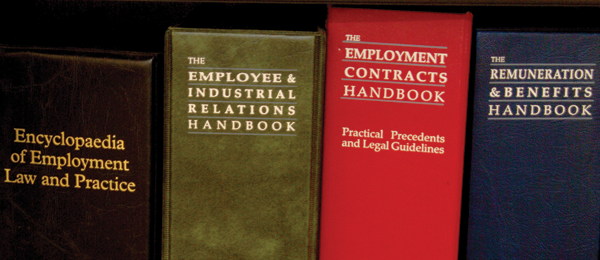If a court employee sues regarding a condition of employment, the proper defendant can be the judge of the court, the state, the county or any combination of these depending upon the cause of action. There are counties with excellent employee handbooks and counties whose handbooks are deficient. Even if the court’s county is one with an excellent handbook and a county attorney who is experienced in county employment issues, the court’s employees are still unique and the court should not solely rely on the county’s resources.
Courts are different from the county entities in their home county. The judges are state officials rather than county officials. However, the judges’ employees are not state employees. Although the employees receive pay and benefits from the county, they are separate and apart from other county employees. It’s important for each court to consider this when deciding whether to have a handbook just for court employees.

Even if the Court decides to adopt the county handbook, there are actions that the Court needs to take to differentiate court employees from county employees. In the articles that I’ve written for Court Times, I have frequently mentioned items that should be included in your employee handbook. This article is written to advise you in one place of key issues specific and crucial to handbooks for court employees.
As a start, the judge needs to make certain court employees know what personnel handbook applies to them. If a judge determines that the county handbook is suitable and wishes to adopt the policies as the court’s own, the judge should issue a written statement to the court employees and to the county commissioners that the judge has adopted the county handbook provisions for the court’s own employees. It’s important that the employees know the judge is their employer and that they are not like all other county employees. It is equally important that the judge let the county commissioners know that the judiciary is separate and that the adoption of the county handbook is a voluntary choice that may be withdrawn at any time. A simple statement is sufficient, such as:
The Circuit Court has determined to adopt and apply the provisions of the County Employee Handbook for court employees. The Court reserves the right to withdraw its adoption of the Handbook at any time without notice. The Court may also supplement and/or amend portions of the Handbook with the Court’s specific provisions.
In addition, as part of the Handbook or as a separate policy, each court needs to give written notice to employees that the court applies the Code of Judicial Conduct to employees. Specifically, employees need to know that they need to conduct themselves not only in their work life, but in their personal life, so that no party to a case would feel or infer that the integrity, impartiality or independence of the Court is compromised by the fact that the employee works for the judge. The Code of Judicial Conduct generates many inquiries from the judges to Adrienne Meiring, Judicial Qualifications Commission/Judicial Nominating Commission (JQC/JNC) counsel because of the many nuances to the Code. Employees can’t be expected to know in what ways the Judicial Code of Conduct applies to them, unless they have been given instruction. Each judge needs to develop policies that set forth basic standards of conduct for the employees in line with the Code of Judicial Conduct.
Another requirement that a judge cannot assume the county has handled properly is compensatory time in lieu of overtime pay. Giving compensatory time in lieu of overtime pay is a strictly construed exception to Fair Labor Standards Act. To be valid, each non-exempt employee needs to sign a compensatory time agreement. Signing the agreement can be a mandatory condition of employment, but there must be proof that the employee worked with the knowledge that by working for the court, the employee was accepting compensatory time in lieu of overtime pay.
Sexual harassment policies and harassment policies are in every employee handbook, good or bad. The policies are of little value however if the policy does not make it clear to whom a report should be made when the employee feels harassed. A policy that says “report to the supervisor” or “to any supervisor” sets the employer up for liability. An employee can then make a report and expect action from “any supervisor.” All too often a supervisor doesn’t recognize that the complaint is a harassment complaint that requires action. This failure to act still becomes notice and creates a potential liability for failure to act on the part of the court employer. A policy that designates an individual for complaints protects against this happening.
Examine also the provisions for discipline in the county handbook before adopting it. If the county handbook provides for progressive discipline, and you do not typically go through the steps of progressive discipline, do not adopt the policy. Further, some counties allow an appeal of significant disciplinary actions to the county commissioners or county council. A judge should never allow the commissioners or any other body to hold a hearing, formal of otherwise, regarding disciplinary decisions for employees. The employees by statute always serve at the will and pleasure of the judge.
The Family & Medical Leave Act (FMLA) allows the employer to determine how time is calculated by the employer when an employee uses FMLA. For eligible employees, the twelve weeks of allowable annual leave can be counted on a calendar year basis, or an annual basis using any set date, such as the date of hire. Most counties adopt this way of measuring time because it is easy. However, the recommended method is to calculate the FMLA on a rolling forward or rolling backward method triggered by the date the employee begins to use FMLA. This is the one method of preventing the most common abuse of FMLA—taking the same three months off every year (winter to go south or summer vacation with the employee’s children). You have to elect the method you will use before the employee asks for FMLA, and then apply that measure to all employees.
Another key issue to examine in the county handbook is its provisions on use of internet and email. At a minimum, the internet and email policies should put the employees on notice that their use of the internet and email is monitored. The language must not be permissive, such as “internet use may be monitored,” but instead state clearly that internet and email use will be monitored periodically. Courts also must be more careful about employees’ use of social media than the county must be of its general employees. Employees should be informed to avoid making social media friends of attorneys, police officers and any one that is a current party before the court. Employees should be advised that no comments may be made in a public forum, including social media, about what is done or heard in Court. Any statements by employees will be imputed to the judge even if the judge is unaware of the statements. Each judge needs to advise employees in writing about the need to conduct themselves on social media sites so that no one will question the independence, impartiality and the integrity of the court because of a post by an employee.
If judges or probation departments wish assistance with review of the county handbook or help in drafting a handbook especially for court employees, you may always seek assistance from the author.
 If a judge needs assistance or advice about these matters, contact Brenda Rodeheffer at (317) 234-3936 or [email protected]
If a judge needs assistance or advice about these matters, contact Brenda Rodeheffer at (317) 234-3936 or [email protected]
Photo by Martin Workman.